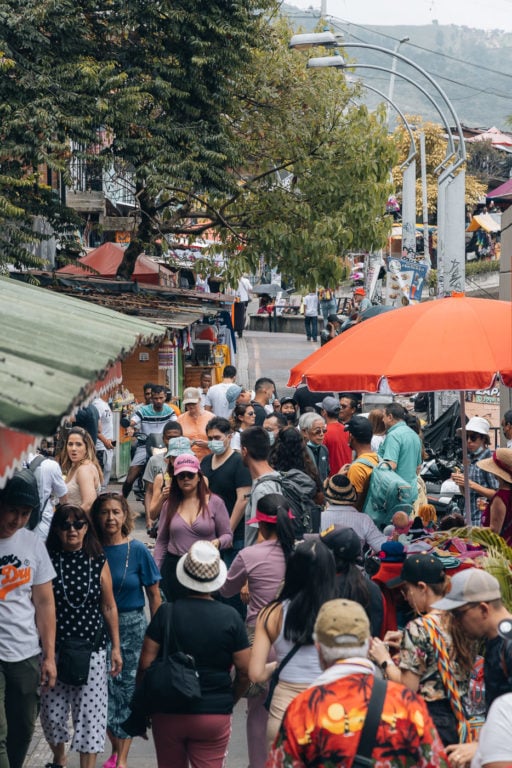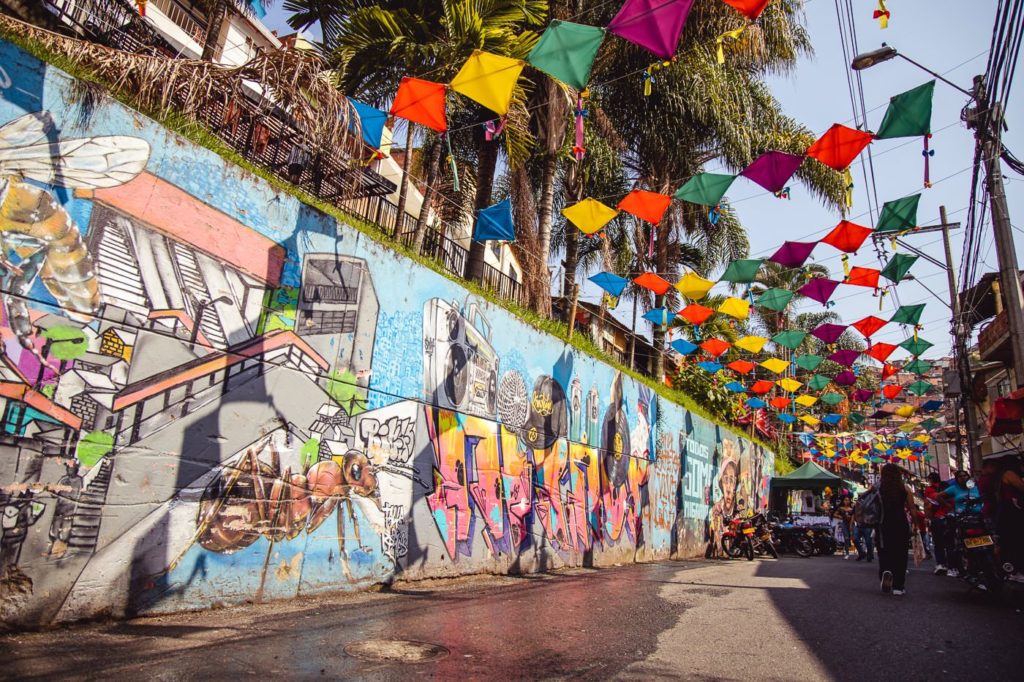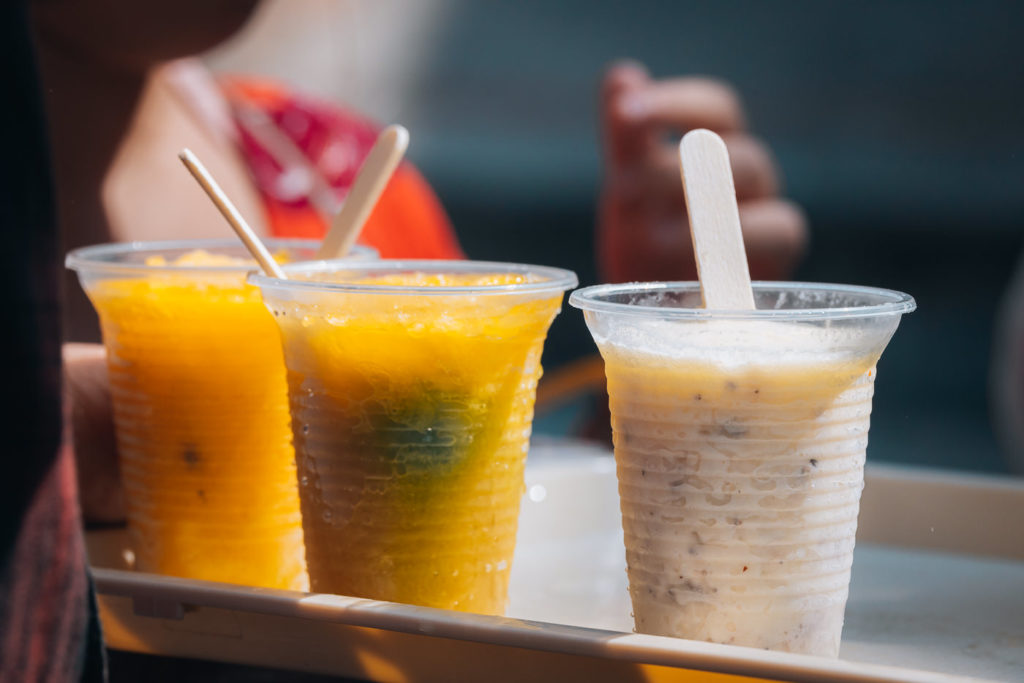A complete and up-to-date guide about the Comuna 13 tour in Medellín, Colombia. Discover the dark history of what was once the world’s most dangerous neighborhood and be inspired by the community’s resilience and colorful transformation.
If you’re looking for a unique cultural experience in Colombia’s Medellín, and to see first-hand, the positive change that has occurred here, then you need to visit Comuna 13.
Here, you can discover inspiring graffiti and street art, watch live rap and break dance performances, immerse yourself in local cafe and coffee culture, learn about the city’s dark history, ride the famous outdoor escalators, and see some of the best views of the City of Eternal Spring.
In this guide, I’ll detail everything you need to know about visiting this amazing cultural icon on a Comuna 13 tour in Medellín. I’ll give you a brief history run-down, provide you an insight on what to expect, and include photos from my visit.
Featured in: 30 Best Things to do in Medellín Colombia



First, What’s the Best Comuna 13 Tour?
When it comes to finding the best Comuna 13 tour in Medellín, you want to make sure that you go with a local guide. There’s no better way to learn about the comuna and its history than from someone who was born and raised in the city.
That’s why I chose to join in with my friend Sebastian. He runs the best-rated Comuna 13 and graffiti tour in Medellín and is highly respected in the Comuna. Additionally, he is highly knowledgable and his guided tour also includes the cable car, and local snacks!
Book: Best-rated Medellín Walking Tour (cable car, Comuna 13 & graffiti tour)

But, isn’t Comuna 13 a Dangerous Area?
The truth is, it’s absolutely true that Medellín was for a long time, the most dangerous city in the world. And, within this city, Comuna 13 was by far one of the most dangerous neighborhoods.
However, due to community-led initiatives, an influx of local government support, and a tireless resilience against violence, the city has seen an explosion of social change.
In fact, Medellín went from being denounced as the most dangerous city in the world just a few decades ago, to earning the crown of most innovative city in 2013.
These days, Comuna 13 is one of the safest districts in Medellín. You’ll find steep hills decorated with vibrant street art, colorful murals, smiling street vendors, and laughing children. It’s completely safe to visit, and it is in-fact the best thing to do in Medellín.

The Definition of Comuna
Many, including Medellín locals associate the term “comuna” with something alike Brazil’s favelas or India’s slums and shanties.
However, Colombia’s definition of Comuna is simply that of its districts. This means that every area in Medellín is in fact, a Comuna and even has an associated number.
For instance, the popular tourist district and upper-class neighborhood of El Poblado is named Comuna 14. However, I was told that the local residents of this high-class area would not be very impressed if I used this term!

A Brief History of Comuna 13 Medellín
If you’re interested in learning the history of violence and subsequent change in Comuna 13 and Medellín in general, then the best way to do that is to take the walking and Graffiti tour of Comuna 13 (above) led by a local.
I’ll do my best at summarizing its history for you. However, remember this is just a very brief history written by an outsider (foreigner). In no way can I inject the emotion and heart that these stories demand.
How Did Medellín’s Most Dangerous Comuna Start?
While Colombia’s global attention seemed to spark during the time of Pablo Escobar and the Medellín Cartel (1972 to 1993), gang violence and poverty have been entrenched in Colombia for far longer.
Poor districts on the hillsides of Medellín like Comuna 13 were originally formed by displaced peasants who were forced to flee their homes due to violence and conflict in rural areas.
This mostly came about due to the so coined La violencia en Colombia (the violence in Colombia). During this time period from 1948 to 1958, violent crime, murder, and paramilitary activity increased dramatically.
An estimated 200,000 Colombians were killed during La Violencia, and many more were displaced. As a response, these poor populations fled to the cities, establishing ghetto districts on the hillsides of Medellín like Comuna 13.

Don’t Miss: Where to stay in Medellín (best neighborhoods)
1970’s & 1980’s – Pablo Escobar
Further immigration waves occurred in the 70’s and beginning of the 80’s due to drug cartel violence, guerrilla groups, and paramilitary armies establishing further conflict areas in rural Antioquia. During this time, an additional 1500 families settled in Comuna 13, establishing Las Independencias I, II, III, and Nuevos Conquistadores (new Conquerors).
Due to its strategic and almost impenetrable location on the slopes of the mountains in Medellín, drug cartels, drug traffickers, and guerrilla groups took control over Comuna 13, turning it into their headquarters for operations throughout the city.
The area became infamous for gang warfare and executions carried out in public as well as for kidnappings. As a result, a constant state of fear surrounded the lives of its residents due to the risk of crossfire.

2000s – Government Interventions & Operation Orion
After years of violent crime, poverty, and conflicts with paramilitary groups and guerrilla armies like the FARC and ELN, the Colombian Government under Alvaro Uribe’s new presidency decided to intervene in Comuna 13.
In 2002, the district faced ten Colombian military operations. The largest was Operation Orion.
This was the last and largest military intervention which saw more than 1500 officers, a tank, and even two helicopters brought into Comuna 13. Unfortunately, nobody knows the true loss of human life due to this operation, as official figures are heavily disputed.
Still, the early 2000s saw further conflicts when paramiliaties took control. During this period, hundreds of people were killed, hundreds more disappeared, and thousands were displaced.


Comuna 13 Today – Inspiring Social Change
Only a few years later, drug cartels took control of Comuna 13 once again.
However, after community-led initiatives to slowly exclude cartels, combined with local government investments into infrastructure like the Cable car line in San Javier Station, the Viaducto Media Ladera, and the installation of electrical escalators rapidly transformed Comuna 13 into the lively, violent-free district it is today.
Related: Hiking Cerro de Las Tres Cruces (Medellín)
What To Expect When Visiting Comuna 13 on a Tour
Interested in immersing yourself in the history and local culture? Want to see and be inspired by the incredible positive and innovative changes? Don’t just read about it, join in on a Comuna 13 tour group in Medellín.
In this section, I’ll briefly outline what to expect based on my experience.
Comuna 13 Tour Starting Point
If you’re taking the walking and graffiti tour that I took (highly recommend), then the meeting point will be at El Poblado metro station.
This is because most visitors to the city will be staying in this district. Additionally, the metro station provides an easy- and well-connected route to the other districts of Medellín.

Cable Car from San Javier Metro Station
In order to get a better perspective and understanding about the history of Medellín and Comuna 13, the tour begins by taking the local transport metro to the San Javier Metro Station.
From here, we took a cable car all the way up the hill, passing Comuna 13 and getting amazing views over the city.
This is great if you’ve still got the metro or cable car on your to-do list, since you’ll get to do both on this Medellín gaffiti tour!

Arriving at Comuna 13
Once we arrived at Comuna 13, it was immediately clear to see why this district was chosen by rebel groups and cartels. Its strategic location on the steep hills of Medellín provides some of the best views across the entire city.
The narrow streets are filled with graffiti and street art, as well as young people and older locals living their everyday life. Hip-hop music emanates from every street corner and the smell of fresh street food fills the air.

Local Street Art on the Medellín Graffiti Tour
As part of the tour, we were taken down some of the back alleys. Here, our guide showcased the work of prominent local graffiti artists.
It was really interesting to learn about how they’ve come to develop their unique styles and what each piece means to them. This is a great way to learn about the history and understand their pain through their urban art.
I won’t spoil too much for you, but below are some pictures of the incredible street art and graffiti murals you’ll find at Comuna 13.


Street Performers & Hip Hop Culture
While we were in Comuna 13, we also had the opportunity to see some of the local street performers. From rap groups to local kids doing magic tricks, to incredible break dancing performances from the Black and White group
These kids and professional dance groups are incredibly talented and put on a great show. It’s really amazing how they’ve been able to use their art to escape from the realities of life in Comuna 13.
We also got to see a bit of the hip hop culture that is so prevalent here. This offered us an opportunity to learn about local life, their music scene, and how it has helped to bring them out of suffering and poverty.

The Cultural Heartbeat of Medellín
Another great part of this Medellín Comuna 13 tour was seeing the local initiatives and commmunity centers. These are very respectable people trying to make a difference in the community. Truthfully, there is a lot of heart and soul here.
One stand out project is called “TOPO Art Medellín” run by John. This initiative provides arts education to kids in the comuna, teaching them about sculpturing, dance, music, and art. It was really inspiring to see the positive impact that this program is having on these kids’ lives.

Graffiti & Art Galleries in Comuna 13
In addition to the amazing street art, there are also several art galleries in Comuna 13 that are worth checking out. These again are dedicated to showcase local art and tell stories about Colombia’s past, including its natural history of flora and fauna, indigenous people, and Medellín’s history.
Some of the most popular are;
- Trece Gallery
- The Toy House
- Aroma de Barrio (Chota_13’s gallery)
- 3C3D – neon gallery
- Casa Kolacho
These art galleries feature the work of local street artists and is also a great place to buy some souvenirs to support the comuna.
However, our guide did not pressure us into purchasing anything and only offered it as an option. Unlike other parts of South America, I actually did not feel any pressure at all to spend money at their stores or souvenir shops.




Related: Best Things to do in Guatapé
Visit Awesome Coffee Shops
Comuna 13 is also home to some of the best coffee shops in Medellín. If you’re a coffee lover, then you’ll definitely want to check out these spots.
The spot we visited is run by Comuna 13’s most famous street artist; Chota_13. His small cafe is actually built underneath his old house and he serves excellent cold drinks, pastries and sells authentic Colombian coffee.
Tip: Try a coffee lemonade from Chota_13’s coffee shop in Comuna 13!

The Famous Outdoor Escalators at Comuna 13 (Las Escaleras)
Of course, on this tour you’ll get to see the infrastructure that connected and facilitated the positive change in Comuna 13. The series of six outdoor electric escalators (Las Escaleras) connected the lower and upper sections of the comuna, turning a 25 minute steep hill climb into a six-minute leisurely trip!
Just imagine how much more connected this made the comuna to the broader cities!
At first glance, these escalators might not seem like much. But now that you understand the history and significance of this infrastructure, you might never take them for granted again.

End of the Tour
After a few hours touring Comuna 13, seeing the incredible street art, immersing yourself in the culture, and trying some local snacks like fruit cremas (ice creams), our guide brought us back to the starting point.
Be sure to thank them for their time and effort – without local guides, this tour would not be possible.




How to Get to Comuna 13 Without A Tour
Again, I highly recommend taking the walking tour or graffiti tour. Learning the stories behind the art and the history of the community from a local makes this a much more memorable experience.
However, if you want to explore Comuna 13 on your own, there are a few ways to get there.
The best way to get to Comuna 13 is by taking the metro (line A) to San Javier (closest metro station). From there, it’s about a 15-20 minute walk to the comuna.
However, you can also take a bus heading up the hill to the top of the hill. You can explore the area on foot and use the escalators to make your way down to the bottom.
Another option is to take a taxi. The price shouldn’t be more than 15,000 pesos if you’re coming from El Poblado or Laureles. You could always take an Uber as well. But, just remember to get in the front seat, as Uber is still illegal in Colombia.

Related: Visit Pueblito Paisa in Medellín
Things To Know About Visiting Comuna 13 (Before You Go)
Below are some more tips and useful things to know about visiting Comuna 13 in Medellín.
- There are no ATMs or banks in Comuna 13. So, make sure you have enough cash on hand before you go.
- You can buy food and drinks here
- Comuna 13 is located high up on a hill. You’ll need to do a bit of walking throughout the day so remember to wear comfortable walking shoes.
- Paisas don’t like talking about Pablo Escobar. While many locals will respect your curiosity, it’s best to avoid bringing it up in conversation.
- You can visit Comuna 13 alone. But, it is best to visit with a local tour guide who knows the area well.
- Be prepared for lots of graffiti and street art as you wander through the comuna. This is one of the main attractions of visiting Comuna 13. So, make sure to take your time looking at all the amazing murals and artwork.
- Some of the best views of the city can be found from up in Comuna 13. My guide even let me fly my drone briefly
- The tour will last around four hours, and you’ll get to see all the main attractions in Comuna 13.
- You’ll get a lot out of visiting this district and it’s sure to leave a positive lasting impression on you. Remember that this is an opportunity to give back. Leave coin or small note tips for local kids and street performers. Buy some snacks or drinks from the stalls.
More Photos from My Tour of Comuna 13









Where to Stay in Medellín
First, can you stay in Comuna 13?
No, there are no hotels or hostels within the actual comuna. However, there are several hotels in the surrounding areas like San Javier. In saying that, I’d still recommend booking your accommodation in some of the more tourist-friendly regions.
The most popular area to stay in Medellín is El Poblado. This is the main tourist district and features plenty of great cafes, nightclubs, restaurants, and activities.
However, if you’re the type who would prefer to detour from the gringo trail, check out Laureles (my favorite), Envigado, or Belén. Below are four great recommendations. However, I recommend checking out my detailed accommodation guide here for more options.
- Elcielo Hotel & Restaurant – The ultimate luxury experience in El Poblado. This is the top-rated 5-star hotel in the city and combines lush greens with a modern wood interior for the perfect luxury ambiance.
- 23 Hotel Medellin – A mid-range jungle-themed hotel with a roof-top pool and access to a hot tub overlooking El Poblado.
- Hotel Casa Laureles – The best-rated hotel in the alternative neighborhood of Laureles. Excellent 4-star luxury for a fraction of the price.
- Rango Hostel Boutique – Probably the best backpacker hostel in Medellín. Features an epic rooftop bar and plenty of co-work and common spaces to hang out.

More Medellín Tours, Experiences & Travel Inspiration
Thanks for reading this guide! I hope it’s given you a better understanding of what to expect when visiting Comuna 13 on a Medellín tour. If you have any questions or comments, please feel free to leave them below. Safe travels!
Looking for more things to do in Medellín? Check out some of my other blog posts below for more Colombia travel inspiration
